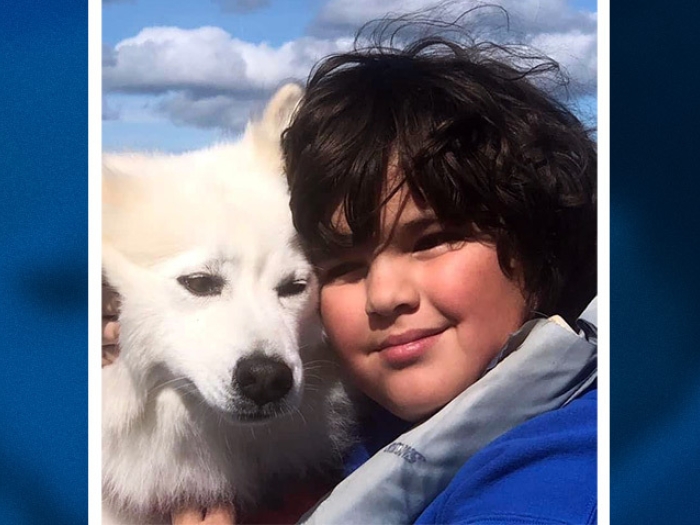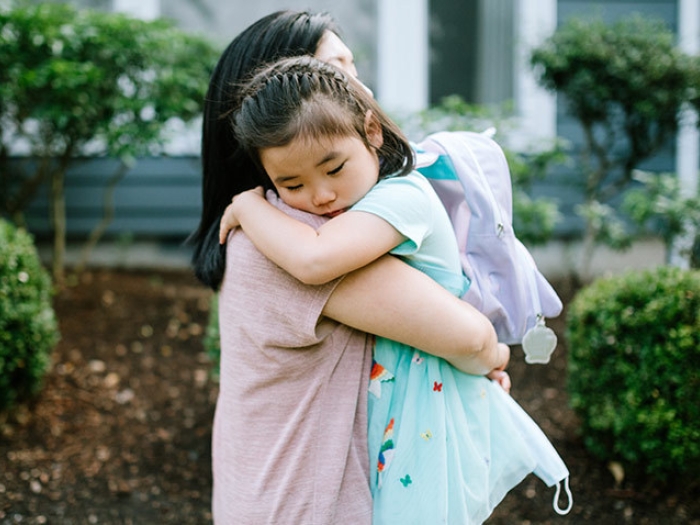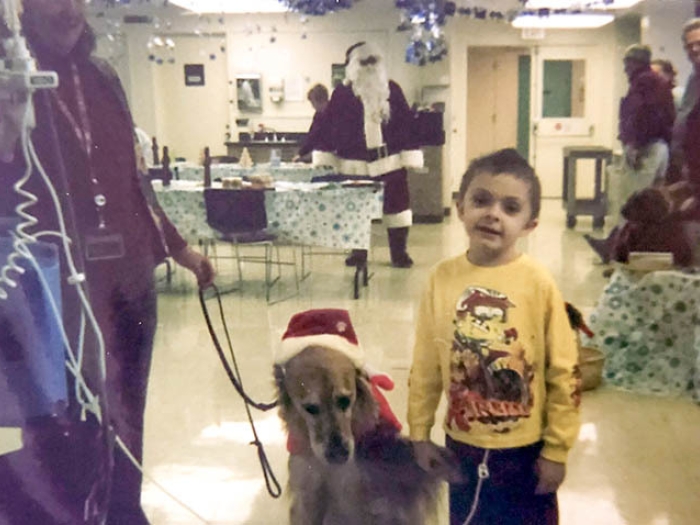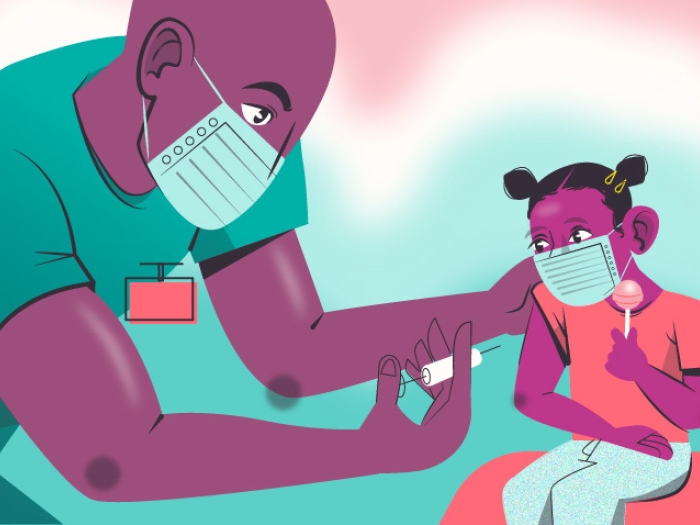As dialogue and protests over longstanding racial injustice continue after George Floyd’s death, it’s critical for families to talk to kids about race and racism.
10:35 AM
Author |

When pediatrician Alanna Nzoma, M.D. sees young children in her clinic, they sometimes notice and ask questions about the differences between their skin color and hers.
"It's normal and natural for children to observe and point out differences. It's our responsibility to help them celebrate these differences and understand how they may affect our lives," says Nzoma, of Michigan Medicine C.S. Mott Children's Hospital.
"I'm an African-American pediatrician. Sometimes pediatric patients with another racial background will ask about my hair or touch my face or want to put our palms up together and see the differences in skin tone."
"I tell them 'yes, we are different colors. We were all made differently.'"
It's never too early to talk to children about race and not doing so is a missed opportunity, Nzoma says.
LISTEN UP: Add the new Michigan Medicine News Break to your Alexa-enabled device, or subscribe to our daily updates on iTunes, Google Play and Stitcher.
As dialogue and protests over longstanding racial injustice continue in communities across the nation after George Floyd's death, it's an especially critical conversation for families to have, experts say.
But parents may not know where to start or be worried about saying the wrong thing. Nzoma weighs in on how parents can work toward being actively anti-racist starting at home.
Don't ignore differences
Some parents falsely believe they are raising their children to be more inclusive by teaching them to be "colorblind" and that if they don't talk about color or race, their children will see everyone as the same.
"Acknowledging difference is a key part of raising awareness and making sure people feel seen and that their backgrounds and lived experiences are valued," Nzoma says.
"It's so important for parents to recognize there is no such thing as being colorblind and we all have biases in how we view other people. When it comes to race, the biases are often negative for brown and Black people."
And without parents guiding these conversations, other influences from media, peers and society will likely shape children's ideas about race.
"Avoiding the conversation may be more comfortable but this only allows your child to absorb society's racial stereotypes, which will likely shape negative views of people of color," Nzoma says.
Parents often call out descriptors when children are young, such as pointing out "a yellow bird" or "blue car" in a book or talking about people being tall or short or young or old. But they may avoid doing the same with skin color or hush their child who points it out.
But this may indicate to children that noticing this difference means 'they're noticing something wrong," Nzoma says. Parents should instead discuss people's differences in a positive way, and when children point them out themselves, families should use the opportunity to promote diversity by talking about why these differences make the world better.
"We should help children understand that skin color doesn't make anyone better or worse," Nzoma says.
Avoiding the conversation may be more comfortable but this only allows your child to absorb society's racial stereotypes, which will likely shape negative views of people of color.Alanna Nzoma, M.D.
Speak in children's language
Children's books can be great conversation starters about race, Nzoma says.
Books that celebrate diversity, such as Sesame Street's "We're Different, We're the Same" by Bobbi Kates and "Everywhere Babies" by Susan Meyers are appropriate for very young children.
Other books address the topic more directly, such as "Let's Talk about Race" by Julius Lester or "The Colors of Us" by Karen Katz, allowing parents to share their values with their kids.
Books or toys that involve diverse families or highlight different cultures are also important.
"Parents should consider intentionally choosing reading or viewing material that positively portrays a Black or Hispanic main character," Nzoma. "This isn't just important for families of color, but other families who want to teach children about different racial and ethnic backgrounds."
Many children learn about the civil rights movement and Black history in school but as they get older, they should also understand how systemic racism has continued through discrimination in housing, jobs, healthcare, education and the criminal justice system.
Animations and simple visuals about systemic racism can be good tools to help explain these concepts. PBS's Sesame Street programs address the protests and racism at a child's level while resources like CNN 10 may help families watch and talk about the news with students and young audiences. Teaching Tolerance, which offers educators resources on talking about race, can also be useful for parents.
Consider a book or movie club for older kids
For older tweens and teens, parents may encourage a book or movie club and invite people from diverse religious, racial and ethnic backgrounds.
"Book and movie clubs that include a diverse audience is a great way for older kids to gain insight," Nzoma says. "It allows them to hear different perspectives and voices about the same content."
Books and movies that involve teenage characters, like Angie Thomas' "The Hate U Give" may appeal to older teens. Documentaries such as Ava Duvernay's "13th," which addresses incarceration of people of color in the U.S., are also more appropriate for older age groups.
Stories from different eras, such as "Hidden Figures," which highlights three Black women's influence at NASA in the 1960's, are also good options.
But Nzoma encourages parents to research books and movies first to check whether they are developmentally appropriate or too graphic for individual teens. Resources like Common Sense Media may help parents gauge the best content on racism and racial justice based on age.
Get out of your bubble
While COVID-19 currently limits some opportunities, Nzoma recommends safely (or virtually) exploring new towns, restaurants, museums, art and culture when possible.
Some cities also host cultural activities, such as African American and Southeast Asian festivals, that families can participate in to celebrate different cultures.
"The pandemic obviously complicates things but if you can, step out of your bubble," Nzoma says.
"Exposing children to other aspects of living is really important. A lot of people have access to these opportunities within a 30-minute radius, but we tend to stick to what we know and what we're comfortable with.
MORE FROM MICHIGAN: Sign up for our weekly newsletter
"Engaging in new cultural experiences opens kids' eyes to how other people live in America and in the world. If there's no exposure to experiences and people that are different from you, the default will likely be negative exposure."
Just making the effort to engage in more of these experiences with your kids and telling them your family is doing so because you know it's important, can go a long way, she says.
Call out racism
When you see something, say something. And your kids will learn to do the same.
This may mean calling out a family member or a friend who makes a racist joke or comment and no longer ignoring uncomfortable subjects at the Thanksgiving table.
"Children observe and learn a lot from their parents' interactions and what isn't said directly to them. The way we show and stand up for our values is very important," Nzoma says.
"Even if it's awkward and challenging, parents should speak up when they hear family or friends say something racist because kids are listening. They likely know that their relative's comment didn't feel right, but recognize that their loved one didn't call out that person."
And then give them the tools to do the same when they encounter racism at school or among peers.
It doesn't need to be confrontational. It can be as simple as teaching them to say "I'm uncomfortable with what you said" or "I don't think that's right or nice to say."
Parents should also help children recognize subtle undertones in media that promote racial stereotypes.
"You might stop the news or a movie and say 'I paused this because I wanted to talk about what we just heard and saw. What did you think about that?' and guide the conversation," Nzoma says.
Parents should also track what YouTube or Twitter accounts their children are using and help them understand that following or sharing racist social media accounts contributes to spreading hate.
Safely participating in demonstrations as a family for Black Lives Matter, in person or virtually, is another way to teach children about the importance of being allies in the fight against racial violence and injustice.
Model relationships
Research suggests that as children age, cross-race friendships become less common.
Parents should look at their own social circles – because their children might be learning this from them.
"Engaging in meaningful, authentic relationships with people who are different from you is leading by example," Nzoma says. "If you want your kids to successfully create relationships with people from different backgrounds, they should see you doing this."
"Children who interact regularly with people from different races in a positive way will likely have fewer biases as they get older," Nzoma says.
Parents should also remember that the first step to raising an anti-racist child, is to be an anti-racist parent. So they too will benefit from educating themselves through books written by Black authors and participating in events where they can learn about experiences that are different from theirs.
Talk about privilege
"Some families think 'privilege' is a dirty word. It shouldn't be," Nzoma says.
"Privilege doesn't mean you've never struggled or had an easy life. There are people who are poor or ill or have other troubles. Privilege just means race is not one of those struggles."
Among those privileges – not having to have what's commonly known as "the talk" in Black communities.
These painful conversations often mean explaining to children of color that they may be more likely to be hurt or be treated unfairly by certain people, even those who are supposed to protect them. Parents prepare their children to stay safe through coaching and ongoing rehearsals of what to do when they encounter authority figures.
Nzoma, who has two children ages eight and 10, has started these talks with her own kids.
"Many Black parents worry that a routine day may turn into a nightmare when their child leaves home because they might be judged unfairly," Nzoma says.
"Privilege describes the reality that a person of color may be punished or treated differently for doing the same thing as a white person, whether that means talking to an authority figure in a certain way or walking late at night in a suburban neighborhood. Research shows that this disparity exists, and children should grasp it."
Keep the conversation going
There is no one right way to talk to children about race and it should be more than a single conversation, Nzoma says.
"I think it's normal for parents to feel worried about making a mistake and saying the wrong thing but they should acknowledge this to children at the beginning," Nzoma says. "
"You can say 'I want to discuss what's going on with racism in our country but I don't have all of the answers. Maybe if we start noticing things and taking action, we can be part of the solution.'
"Families should continue talking about race and educating themselves so they can learn together. It will take a consistent effort over time."

Explore a variety of healthcare news & stories by visiting the Health Lab home page for more articles.

Department of Communication at Michigan Medicine
Want top health & research news weekly? Sign up for Health Lab’s newsletters today!





